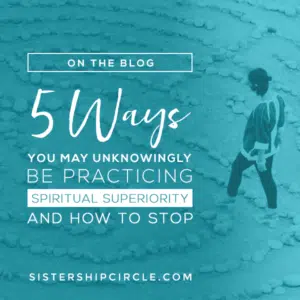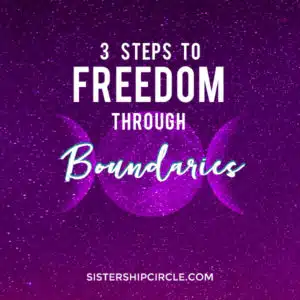As I prepare to give birth to my second daughter, I am more conscious than ever about the importance of the six main rites of passages that women go through.
I want both of my daughters to love being a girl and celebrate becoming a woman. I want them to know in every cell of their bodies that it is an honor to be born a female. To not think of their period as dirty and gross, to not think that giving birth is a horrible thing, to not think that their lives are over with once they stop bleeding.
I want every little girl to grow up proud of her changing body and honoring the transitions she goes through throughout her life. To see each change as a rebirth process, accepting that death is a part of life and only helps us to find more meaning in our lives.
And I believe that the way to create this new culture of celebrating what it means to be a woman is through Blessing Ceremonies, also know as Blessingways, to honor a rite of passage.
What is a Blessingway
A Blessingway is an ancient Navajo sacred spiritual ceremony performed by the Navajo people to celebrate rites of passage that occur throughout the entire life cycle. The Navajo have a saying, “whatever happens here on Earth must first be dreamed”, and that’s exactly what a Blessingway does. It is a ceremony (or the “dream”) that is a prelude to a major life event.¹
The Navajo have expressed that people honor their culture by not calling a non-Navajo ceremony a Blessingway, but instead to use something more appropriate like a “Mother Blessing.” We will call them collectively Blessing Ceremonies.
What is a Rite of Passage
A rite of passage is a ceremony to mark the transition in someone’s life. While most synonymous with the transition from boy to man or girl to woman, it refers to any of life’s transitions such as Births and Beginnings, Initiations, Partnerings, and Endings or Death.
The Four Life Seasons and Their Rites of Passages
Spring – Birth and Menarche
For women, we can find the six main rites of passages within the four seasons of her life related to her fertility and sexuality.
The first life season is defined as the Maiden from birth to childbirth, known as Spring. Two rites of passages are distinguished here: Birth and The Menarche, or initiation of menstruation, also known as first blood or first moon.
Birth Blessing
Typically, we think of honoring the Mother for birthing the child since she is going through more of a conscious rite of passage. But when you think about it, entering the world from the dark spiritual realm of the womb into the physical realm can be quite traumatic and shocking. It may seem as if the infant doesn’t necessarily need a Blessing Ceremony, but I believe it is quite important.
I’ve done two different Birth Blessing for my daughters. One consisted of a few days before giving birth, on the new moon, to sit outside with various objects to set intention and then create an altar for the baby’s arrival. I drew oracle cards as well as introduced her spirit to the 5 elements (water, fire, earth, metal and air) with a ceremony to ease her transition from spirit to physical realm.
The other Birth Blessing occurred 5 days after my first daughter was born. We laid her down in the middle of my women’s circle and sang her name. This came from an African myth I heard where the mother meditated to find the Song of a Child, then the community sings this song after the child’s birth and during other rites of passages.
Menarche Blessing
I can remember getting my first period vividly. It was New Year’s Day and I was 11 years old. I went to the bathroom and found a brownish red mark on my underwear. I called my mom who excitedly proclaimed: “That’s your period! You are now a woman!” And that was it.
Since most women did not receive a Menarche Blessing, we created one for our Facilitator Tribe Members that they can then use for their women’s circles and also modify for their daughters.
Summer – Motherhood and Marriage
The second life season is defined as the Mother from childbirth to menopause, known as Summer. Each time she gives birth, she goes through a rite of passage to deepen her experience of Motherhood. Another rite of passage worth mentioning is for Marriage, which happened during my Summer Season, but may happen during any Life Season.
Mother and Bridal Blessings
I received two beautiful Mother Blessings for each daughter, as well as one before I got married, which I’ll outline below.
Autumn – Menopause
The third life season is defined as Maga from menopause to retirement, known as Autumn. Maga is intended as the feminine version of Magus – the wise man, magician.² The main rite of passage distinguished here is Menopause, when menstruation stops and Maga begins. This season is all about harvesting her life skills and shifting focus from her own family to community.
Wise Woman Blessing
Our culture does not honor the passage a woman takes when she stops bleeding. She’s considered old, worthless to society, and tossed aside. By honoring the mark of the last blood and honoring her transitioning into her later years, she can see how much value she has to offer her community and the world. This is the time of legacy creation and give back. We need her wisdom and knowledge more than ever. Creating a Wise Woman Blessing Ceremony is one of the most important rituals we can perform for her.
Winter – Death
The fourth and final Life Season is defined as Crone from retirement to death, known as Winter, when she withdraws from the busyness of life.³
Death Blessing
This differs from a funeral in that it is honoring the rite of passage before she transitions to the other side. The intention of this Blessing Ceremony is to ease her transition, have her feel complete, and pass down her wisdom to the future generations.
How to Perform a Blessing Ceremony
Whether it is for Menarche, Mother, Bridal, Wise Woman or Death, all of these Blessing Ceremonies can follow the same structural outline to honor all facets of the rite of passage. A woman can call forth her sisters to gather with her as she leads her own ceremony or ask someone to facilitate. A sister can also offer to perform the ceremony for her friend going through the rite of passage. Family, friends and community members can be present. While most of these ceremonies are typically women-only, they can also be performed in a co-ed environment.
Phase 1: Opening
Always start by creating sacred space for the ceremony. This consists of gathering everyone together in a circle. First, light a candle to represent the start of the ceremony. Then state the intention for the gathering. You can then say a prayer, invocation or poem to anchor the intention.
Because this is a community ceremony, each woman states her name and a short intention for being there to bring her energy into the collective field and have everyone feel connected.
Phase 2: Release the Fear
Once the container is open, the woman going through the rite of passage shares her limited beliefs, fears, doubts and worries about the transition. If she is open to receiving support from the circle, others may contribute their encouragement to release those fears.
Phase 3: Acknowledging the Lessons, Death, and Rebirth
Once she has shared all of her fears, she acknowledges the death of her old self. With any rite of passage, you are transitioning out of one stage and into the other and will never be the same again. This can be quite scary and confronting as this may have been the way we’ve known ourselves for decades. By acknowledging the death, we are then reborn and learn from the lessons of our past.
She can share the lessons she has learned so far on her journey leading up to this rite of passage, and acknowledge the shadow of death and all that she feels about it. A few ways to physically demonstrate this in ritual form is: walking down a pathway in the middle of the circle, the women can all make a tunnel where she walks through the middle, or the ones who have not been through this rite of passage stand behind her while the ones who already have stand in front of her.
Phase 4: Set Intentions
Next, she sets her intention for the next stage of her life. What does she want to create? What is she looking forward to? What desires does she hold in her heart? Once she speaks about her future, she can then either cross over a line marked before her, or do something to symbolize the passage to the other side.
Phase 5: Community Blessings & Ritual
Once she feels complete with speaking about her journey, the community then offers blessings. Those who have completed this rite of passage already can share inspiring and empowering stories about their own transitions. Those who have not can share encouragement and support for who they see her becoming.
A ritual such as creating a dreamcatcher, birthing necklace or painting symbolizes the community putting their collective intentions drawn from this Ceremony into an object to remind her that she is supported.
Finally, the community places healing hands on her to give her nurturing touch and let her know they are physically there for her when she makes it to the other side.
Phase 6: Celebration Feast
To complete the Ceremony, sing a song, read a poem and/or blow out the candle to signify the closing of sacred space. Then everyone eats together (usually potluck style) to ground the energy and shift from sacred to social space.
Using this format, the community can then add in specific rituals that pertain to the type of Blessing it is. Most significantly, the community shows up to give their energetic, emotional and physical support to the woman so that she finds the courage, strength and faith to go through this transition.
Rarely do we talk about the grief and fear that a woman experiences as she finds herself in the midst of transition. By performing these Blessing Ceremonies for the women in our lives, we reinforce sisterhood, letting women know they are not alone on their journey, giving them a safe space to talk about what they are experiencing and permission to feel all that is coming up.
Through Blessing Ceremonies, we normalize and integrate the shadow, creating healthier, more empowered women on the planet. With this level of nurturing and support, women feel so much more empowered as they pass from Life Season to Season, from one stage to the next, finding life more meaningful, rich and sacred.
Take Action
Have you been given or performed a Blessing Ceremony? What was your favorite part? Please contribute any rituals that you loved so that we can collectively share.
Want more rituals?
We have created the Women’s Circle Ritual Handbook which features rituals from 40 facilitators around the world. You can get your copy of the handbook HERE.
Share the Love
If you are in need of a Blessing Ceremony, share this with your sisters to help you create one for yourself; you deserve it.
If you have a sister who is about to experience a rite of passage, share this with her and ask if she’s open to receiving one.
¹ http://www.cwhn.ca/en/node/39613
² http://www.moonsong.com.au/evolution-of-the-triple-goddess/
³ http://www.moonsong.com.au/honoring-rites-of-passage-in-a-womans-life/







